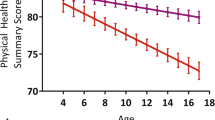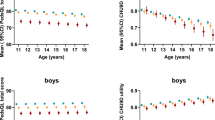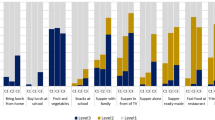Abstract
Objective:
To investigate the relationship between excess weight (overweight and obesity) and health-related quality of life (HRQoL) in a sample of secondary school children in Fiji, by gender, age and ethnicity.
Methods:
The study comprised 8947 children from forms 3–6 (age 12–18 years) in 18 secondary schools on Viti Levu, the main island of Fiji. Body mass index (BMI) was calculated from measured height and weight, and weight status was classified according to the International Obesity Task Force recommendations. HRQoL was measured by the self-report version of the Pediatric Quality of Life Inventory 4.0.
Results:
HRQoL was similar in children with obesity and normal weight. Generally, this was replicated when analyzed separately by gender and ethnicity, but age stratification revealed disparities. In 12–14-year-old children, obesity was associated with better HRQoL, owing to better social and school functioning and well-being, and in 15–18-year olds with poorer HRQoL, owing to worse physical, emotional and social functioning and well-being (Cohen’s d 0.2–0.3). Children with a BMI in the overweight range also reported a slightly lower HRQoL than children with a BMI in the normal weight range, but although statistically significant, the size of this difference was trivial (Cohen’s d <0.2).
Discussion:
The results suggest that, overall there is no meaningful negative association between excess weight and HRQoL in secondary school children in Fiji. This is in contradiction to the negative relationship between excess weight and HRQoL shown in studies from other countries and cultures. The assumption that a large body size is associated with a lower quality of life cannot be held universally. Although a generally low HRQoL among children in Fiji may be masking or overriding the potential effect of excess weight on HRQoL, socio-economic and/or socio-cultural factors, may help to explain these relationships.
This is a preview of subscription content, access via your institution
Access options
Subscribe to this journal
Receive 12 print issues and online access
$259.00 per year
only $21.58 per issue
Buy this article
- Purchase on Springer Link
- Instant access to full article PDF
Prices may be subject to local taxes which are calculated during checkout


Similar content being viewed by others
References
Noncommunicable diseases. Country profiles 2011. World Health Organization: France, 2011. Report no.: 978 92 4 150228 3.
Catenacci VA, Hill JO, Wyatt HR . The obesity epidemic. Clin Chest Med 2009; 30: 415–444.
Anderson SE, Cohen P, Naumova EN, Jacques PF, Must A . Adolescent obesity and risk for subsequent major depressive disorder and anxiety disorder: prospective evidence. Psychosom Med 2007; 69: 740–747.
Bradford NF . Overweight and obesity in children and adolescents. Primary Care 2009; 36: 319–339.
Griffiths LJ, Parsons TJ, Hill AJ . Self-esteem and quality of life in obese children and adolescents: a systematic review. Int J Pediatr Obes 2010; 5: 282–304.
Ul-Haq Z, Mackay DF, Fenwick E, Pell JP . Meta-analysis of the association between body mass index and health-related quality of life among children and adolescents, assessed using the pediatric quality of life inventory index. J Pediatr 2012; 162: 280–286.
Tsiros MD, Olds T, Buckley JD, Grimshaw P, Brennan L, Walkley J et al. Health-related quality of life in obese children and adolescents. Int J Obes 2009; 33: 387–400.
Gibson LY, Byrne SM, Blair E, Davis EA, Jacoby P, Zubrick SR . Clustering of psychosocial symptoms in overweight children. Aust N Z J Psychiatry 2008; 42: 118–125.
Williams J, Wake M, Hesketh K, Maher E, Waters E . Health-related quality of life of overweight and obese children. JAMA 2005; 293: 70–76.
Tyler C, Johnston CA, Fullerton G, Foreyt JP . Reduced quality of life in very overweight Mexican American adolescents. J Adolesc Health 2007; 40: 366–368.
Williams JW, Canterford L, Hesketh KD, Hardy P, Waters EB, Patton GC et al. Changes in body mass index and health related quality of life from childhood to adolescence. Int J Pediatr Obes 2011; 6: e442–e448.
Keating CL, Moodie ML, Swinburn BA . The health-related quality of life of overweight and obese adolescents-a study measuring body mass index and adolescent-reported perceptions. Int J Pediatr Obes 2011; 6: 434–441.
Kunkel N, Oliveira WF, Peres MA . Overweight and health-related quality of life in adolescents of Florianopolis, Southern Brazil. Rev Saude Publica 2009; 43: 226–235.
Vissers D, Devoogdt N, Gebruers N, Mertens I, Truijen S, Van Gaal L . Overweight in adolescents: differences per type of education. Does one size fit all? J Nutr Educ Behav 2008; 40: 65–71.
Wu XY, Ohinmaa A, Veugelers PJ . Diet quality, physical activity, body weight and health-related quality of life among grade 5 students in Canada. Public Health Nutr 2012; 15: 75–81.
Ostbye T, Malhotra R, Wong HB, Tan SB, Saw SM . The effect of body mass on health-related quality of life among Singaporean adolescents: results from the SCORM study. Qual Life Res 2010; 19: 167–176.
Al-Akour NA, Khader YS, Khassawneh MY, Bawadi H . Health-related quality of life of adolescents with overweight or obesity in the north of Jordan. Child Care Health Dev 2012; 38: 237–243.
Koot HM . The study of quality of life: concept and methods. In: Koot HM, Wallander JL (eds). Quality of Life in Child and Adolescent Illness: Concepts, Methods and Findings. Brunner-Routledge Hove: UK, 2001.
Kuyken W . The World Health Organization Quality of Life assessment (WHOQOL): position paper from the World Health Organization. Soc Sci Med 1995; 41: 1403–1409.
McCabe MP, Mavoa H, Ricciardelli LA, Schultz JT, Waqa G, Fotu KF . Socio-cultural agents and their impact on body image and body change strategies among adolescents in Fiji, Tonga, Tongans in New Zealand and Australia. Obes Rev 2011; 12 (Suppl 2): 61–67.
Sato H, Nakamura N, Sasaki N . Effects of bodyweight on health-related quality of life in school-aged children and adolescents. Pediatr Int 2008; 50: 552–556.
Schultz JT, Tuivaga J . 2004 National Nutrition Survey, Main Report. National Food and Nutrition Centre: Suva, Fiji, 2007.
Global School-based Student Health Survey, Fiji. 2010 Fact Sheet. Available at http://www.who.int/chp/gshs/en. World Health Organisation, 2010.
Petersen S, Mavoa H, Swinburn B, Waqa G, Goundar R, Moodie M . Health-Related quality of life is low in secondary school children in Fiji. Int J Pediatr 2012; 2012: 10.
Fiji Facts and Figures as at 1st July 2010. Fiji Islands Bureau of Statistics: Suva, Fiji, 2010.
Swinburn BA, Millar L, Utter J, Kremer P, Moodie M, Mavoa H et al. The Pacific Obesity Prevention in Communities project: project overview and methods. Obes Rev 2011; 12 (Suppl 2): 3–11.
Kremer P, Waqa G, Vanualailai N, Schultz JT, Roberts G, Moodie M et al. Reducing unhealthy weight gain in Fijian adolescents: results of the Healthy Youth Healthy Communities study. Obes Rev 2011; 12 (Suppl 2): 29–40.
Mathews L, Kremer P, Sanigorski A, Simmons A, Nichols M, Moodie M et al. Nutrition and Physical Activity in Children and Adolescents: Report 1: methods and tools. Department of Human Services (Victoria), Deakin University: Australia, 2009.
Varni JW, Seid M, Kurtin PS . PedsQL 4.0: reliability and validity of the Pediatric Quality of Life Inventory version 4.0 generic core scales in healthy and patient populations. Med Care 2001; 39: 800–812.
Limbers CA, Newman DA, Varni JW . Factorial invariance of child self-report across age subgroups: a confirmatory factor analysis of ages 5 to 16 years utilizing the PedsQL 4.0 Generic Core Scales. Value Health 2008; 11: 659–668.
Petersen S, Hagglof B, Stenlund H, Bergstrom E . Psychometric properties of the Swedish PedsQL, Pediatric Quality of Life Inventory 4.0 generic core scales. Acta Paediatr 2009; 98: 1504–1512.
Limbers CA, Newman DA, Varni JW . Factorial invariance of child self-report across race/ethnicity groups: a multigroup confirmatory factor analysis approach utilizing the PedsQL 4.0 Generic Core Scales. Ann Epidemiol 2009; 19: 575–581.
Cohen J . Statistical Power for the Behavioral Sciences 2 edn Lawrence Erlbaum: New York, USA, 1988.
Edwards TC, Patrick DL, Skalicky AM, Huang Y, Hobby AD . Perceived body shape, standardized body-mass index, and weight-specific quality of life of African-American, Caucasian, and Mexican-American adolescents. Qual Life Res 2012; 21: 1101–1107.
Swallen KC, Reither EN, Haas SA, Meier AM . Overweight, obesity, and health-related quality of life among adolescents: the National Longitudinal Study of Adolescent Health. Pediatrics 2005; 115: 340–347.
Narsey W . Report on the 2008-09 Household Income and Expenditure Survey for Fiji. Fiji Islands Bureau of Statistics: Suva, Fiji, 2011.
Lobstein T, Baur L, Uauy R . Obesity in children and young people: a crisis in public health. Obes Rev 2004; 5 (Suppl 1): 4–104.
von Rueden U, Gosch A, Rajmil L, Bisegger C, Ravens-Sieberer U . Socioeconomic determinants of health related quality of life in childhood and adolescence: results from a European study. J Epidemiol Community Health 2006; 60: 130–135.
Felder-Puig R, Baumgartner M, Topf R, Gadner H, Formann AK . Health-related quality of life in Austrian elementary school children. Med Care 2008; 46: 432–439.
Tsiros MD, Coates AM, Howe PR, Grimshaw PN, Buckley JD . Obesity: the new childhood disability? Obes Rev 2011; 12: 26–36.
Haraldstad K, Christophersen KA, Eide H, Nativg GK, Helseth S . Predictors of health-related quality of life in a sample of children and adolescents: a school survey. J Clin Nurs 2011; 20: 3048–3056.
Janssen I, Craig WM, Boyce WF, Pickett W . Associations between overweight and obesity with bullying behaviors in school-aged children. Pediatrics 2004; 113: 1187–1194.
Forste R, Moore E . Adolescent obesity and life satisfaction: Perceptions of self, peers, family, and school. Econ Hum Biol 2012; 10: 385–394.
Williams LK, Ricciardelli LA, McCabe MP, Waqa GG, Bavadra K . Body image attitudes and concerns among indigenous Fijian and European Australian adolescent girls. Body Image 2006; 3: 275–287.
McCabe M, Fuller-Tyszkiewicz M, Mellor D, Ricciardelli L, Skouteris H, Mussap A . Body satisfaction among adolescents in eight different countries. J Health Psychol 2012; 17: 693–701.
Ricciardelli LA, McCabe MP, Mavoa H, Fotu K, Goundar R, Schultz J et al. The pursuit of muscularity among adolescent boys in Fiji and Tonga. Body Image 2007; 4: 361–371.
Stevens J . Obesity and mortality in Africans-Americans. Nutr Rev 2000; 58: 346–353.
Annual Reports. Ministry of Education. Fiji Islands Bureau of Statistics In Fiji Islands Bureau of Statistics: Suva, Fiji, 2011.
Acknowledgements
We thank the many people involved in the Pacific OPIC Project for their work that made this study possible, including other coinvestigators, staff and postgraduate students, partner organizations and especially the students, teachers, parents and communities. The project was funded by the Wellcome Trust (UK), the National Health and Medical Research Council (Australia) and the Health Research Council (New Zealand) through their International Collaborative Research Grant Scheme. The current paper was processed by additional funding from the Swedish Council for Working Life and Social Research (Sweden).
Author information
Authors and Affiliations
Corresponding author
Ethics declarations
Competing interests
The authors declare no conflict of interest.
Rights and permissions
About this article
Cite this article
Petersen, S., Moodie, M., Mavoa, H. et al. Relationship between overweight and health-related quality of life in secondary school children in Fiji: results from a cross-sectional population-based study. Int J Obes 38, 539–546 (2014). https://doi.org/10.1038/ijo.2013.212
Received:
Revised:
Accepted:
Published:
Issue Date:
DOI: https://doi.org/10.1038/ijo.2013.212
Keywords
This article is cited by
-
Prevalence of body dissatisfaction and its effects on health-related quality of life among primary school students in Guangzhou, China
BMC Public Health (2019)
-
Weight associated factors in relation to health-related quality of life (HRQoL) in Iranian adolescents
Health and Quality of Life Outcomes (2019)
-
Health-related quality-of-life model in adolescents with different body composition
Eating and Weight Disorders - Studies on Anorexia, Bulimia and Obesity (2019)
-
Human development index, children’s health-related quality of life and movement behaviors: a compositional data analysis
Quality of Life Research (2018)
-
Is overweight associated with health-related quality of life (HRQoL) among Tehranian school children?
SpringerPlus (2016)



